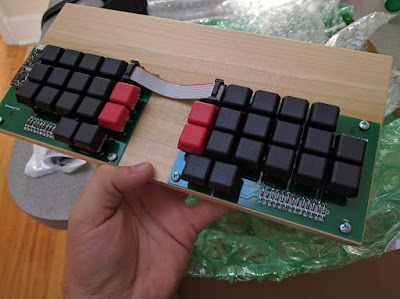16 KiB
Note: This page is for general users who are new to steno. If you're a steno professional, read Plover and Professional Stenography.
Table of Contents
Stenography:
- What is stenography?
- How does it work?
- Why learn steno? And how?
- Why isn't steno more popular than QWERTY?
Plover open source stenography software:
- What is Plover?
- How is Plover different from commercial steno programs?
- What does Plover look like in action?
- Why was Plover written?
- What hardware is needed to use Plover?
- What can Plover do right now?
- What Plover cannot do right now
- Non-English languages
- Is an NKRO keyboard as fast as a steno machine?
- How many people currently use Plover?
- Who's responsible for Plover's development?
- Why "Plover"?
- Does the Plover Project accept donations?
What is stenography?
Stenography is a form of shorthand writing/typing, usually done on a special machine (although with Plover, you can use computer keyboard that has n-key rollover). It was invented in the early 1900s.
Real-time machine stenography is a code translation system that lets users enter words and syllables by pressing multiple keys simultaneously in a chord, which is then instantly translated into English text.
This makes steno the fastest and most accurate text entry method currently available.
| Method | Typical Speed |
|---|---|
| Handwriting | 30 WPM |
| Average Typist | 40 WPM |
| Fast Typist | 120 WPM |
| Typing World Record | 200 WPM |
| Voice Writer | 180 WPM |
| Average Speech | 200 WPM |
| Amateur Stenographer | 160 WPM |
| Professional Stenographer | 225 WPM |
| Steno World Record | 360 WPM |
In the first year of steno school, many students learn to exceed 100 words per minute. By comparison, top qwerty typists can do 120 WPM, top Dvorak typists around 140 WPM, and voice writers dictating to voice recognition software around 180 WPM. But experienced stenographers can enter text at up to 300 words per minute (the world record is actually 360, but that's an outlier). Conceivably, with practice, amateur steno users could reach 160-200 words per minute.
How does it work?
The main difference between typing and stenography
Typing is (usually) data entry with single fingers
Most likely, you are using a qwerty or dvorak keyboard layout to type everything out character by character. If you ever practiced piano, it might be helpful to liken them to certain piano pieces common in a pianist's repertoire. The "typewriter-style" systems (qwerty, dvorak, etc.) are like Chopin's Fantasie Impromptu:
Notice how this piece—like typing—is mainly runs of single fingers. When you learn and practice this piece, you often do many finger exercises to strengthen certain fingers to increase your speed.
Stenography is chorded data entry, using multiple fingers
However, Plover, and other steno systems, use keyboard "chords" to type syllables, words, or entire phrases. You press keys, and lift off, rather than pressing down individual keys one after the other.
"When your fingers are in position, press them all down together, and release them. Out comes the word 'tap'! You've just tapped your first word in steno! Notice that it doesn't really matter that all the keys go down absolutely simultaneously. The only thing Plover cares about is that there's one moment in time when all three keys are down together."
(From Learn Plover!)
Plover - and all steno systems - express words primarily as groups of sounds rather than groups of letters of the alphabet.
"Steno-style" systems (NYCI, StenoEd, Phoenix, etc.) are like Rachmaninoff's Prelude in G Minor:
Unlike the Chopin, this piece is almost entirely chorded. When learning a piece like this, you learn how to block your chords. So your approach to learning steno may be completely different than learning a different keyboard layout, since it's a completely different system.
Why learn steno? And how?
Mirabai Knight has broken the answer to the first question into six parts:
- How to Speak With Your Fingers: for people who can't use their voice to speak but want to communicate in real-time using a steno-enabled text to speech device.
- Writing and Coding: for people whose fluency of thought depends on ease and efficiency of text input.
- The Ergonomic Argument: for people who want to avoid wasted effort and repetitive stress injuries.
- Mobile and Wearable Computing: for people who want to input text and control their computers while walking around, with a minimum of dorkitude.
- Raw Speed: for people who have to be the fastest, no matter what.
- CART, Court, and Captioning: for people who want to provide live verbatim transcription professionally.
For learning, the best resource is Learn Plover! by Zack Brown.
Why isn't steno more popular than QWERTY?
There are a number of possible reasons:
- Stenography was copyrighted for many decades, which limited the amount of competition in the marketplace.
- The vendors decided to focus on high value products in market sectors where organizations would be willing to pay higher prices.
- It takes longer to learn how to write with steno than it does learning how to type.
- Plover software, and suitable low cost hardware, didn't exist until recently.
What is Plover?
Plover is the world's first free, open-source stenography program. It is a small Python application that you run in the background. It acts as a translator to read steno movements and then emulate keystrokes, so the programs you use can't tell that you are using steno.
Plover is available on Windows, Mac and Linux. Plover. To download, see the Releases page.
How is Plover different from commercial steno programs?
Well, first off, it's free. Free to distribute, free to modify. No dongles, no upgrade fees, no constraints. That's already a $4,000 difference.
To the developer's knowledge, it's also the only steno software that works on a buffer-based system rather than a timer-based system, and that has direct access to the OS rather than filtering everything into a steno-specific word processor. This means it's lightweight, powerful, and doesn't require a 1.5-second wait time between when a stroke is entered and when the translation appears in an external program. In Plover, the translation appears instantly, and the software isn't cluttered up with file managers, printer handlers, and other court-reporting flimflam that an amateur stenographer will never use. Instead, it's a direct conduit between the steno keyboard and the OS. Plover can do everything a qwerty keyboard can do – but much, much faster.
What does Plover look like in action?
Here is a video of Ted Morin using Plover to write some simple JavaScript code:
Here is a demonstration of Plover with a Qwerty Keyboard. It shows the keys pressed along with their resulting output. See Mirabai's blog post
Here's a video of Mirabai kicking someone's butt in TypeRacer, an online typing game that lets people race against each other by hammering out random snippets of text at high velocities:
And here's a demonstration of Plover with eSpeak, a free text-to-speech engine, which can be a way to talk at a normal conversational pace by people who don't use their voices to speak, as discussed in How to Speak With your Fingers.
Why was Plover written?
A professional stenographer, forced to buy proprietary (and DRM-riddled) steno software for $4,000 plus an annual $700 upgrade fee after shelling out for a $3,000 steno machine, looked around and saw that most of the people who made their living and their free time putting text up on a screen were crawling along at around 60 words per minute because they were using qwerty instead of steno. She realized that the only way to spread the wonders of high speed efficient text entry to the geeks, hackers, writers, and internet addicts who desperately needed it was to make the software free and the hardware cost less than $60. She found a Python programmer who was also a hardware maven, and they both got down to work. Eleven months later, Plover was ready for prime time.
What hardware is needed to use Plover?
See the supported hardware page.
What can Plover do right now?
Plover can write properly capitalized and punctuated text into any window as if it were an ordinary keyboard. It can send command strokes such as Enter or Escape, giving it complete equivalence to the Qwerty keyboard. It's also a robust and convenient text entry system, suitable for writing, coding, chatting, and kicking people's butts at online typing games.
What Plover cannot do right now
####Sticky Metakeys
Plover lacks arbitrarily stackable metakeys. You can explicitly define a metakey+key combination in the dictionary (and there is a dictionary for general shortcuts such as Control-C), but you can't map a stroke to, say, Control and then be able to simulate holding it down while choosing another key in realtime to be activated along with it.
Transcript management and workflow
Plover is not court reporting (CAT) software, and there are no plans to make it into CAT replacement software. It has no transcript preparation utilities of any kind. For example: document approval and delivery workflow, document encryption, or file management.
For more information, see:
Is Plover going to put CAT software companies out of business?
Non-English languages
The Plover software is currently designed for the English steno keyboard layout, but it is possible to customize the steno layout. Some unofficial work has been done by users on creating French, German and Portuguese versions, by forking the software from the repository to create versions for other language layouts.
There has been some work on developing free-of-charge steno dictionaries for other languages (for example, French, German (1 and 2), Portuguese and Spanish), which could be used while retaining the English steno keyboard layout.
Plover can also work with exported dictionaries from commercial stenography applications such as Eclipse, ProCAT and Case CATalyst.
More information:
Is an NKRO keyboard as fast as a steno machine?
No. It's definitely clunkier and squishier than a genuine lever-based steno machine, and a certain amount of accuracy and speed is necessarily sacrificed because of that. It's also somewhat more fatiguing, because it requires more force to press the keys and their travel depth is deeper than most modern steno machines.
However, it's perfectly possible for a trained stenographer to reach speeds of 220 WPM or higher using something like a Sidewinder X4, especially if they have the optional laser-cut steno keytoppers ($20 from the Plover store):
Various steno enthusiasts are making and selling machines designed for use with Plover. These typically use keys that require less actuation force than the keys found on a qwerty keyboard, and they have the steno "22 key" ortholinear layout. They usually cost more than an NKRO qwerty keyboard and less than a professional steno machine. See Dedicated machines designed for use with Plover.
How many people currently use Plover?
Hard to say, since people are free to download and distribute the software as much as they want without asking permission. However, the Plover Google Group currently has 578 members.
Who's responsible for Plover's development?
Plover was originally created by Mirabai Knight and Joshua Harlan Lifton, and is the software arm of The Open Steno Project, an umbrella organization for open source steno tools. The current lead developer is Theodore (Ted) Morin.
Why "Plover"?
The short answer is that it's a two-syllable, six-letter word that can be written in a single stroke on a steno machine. The longer answer is here.
Does the Plover Project accept donations?
Absolutely. Contributions of money, code, testing, documentation, publicity, or TypeRacer cannon fodder are gratefully accepted.








